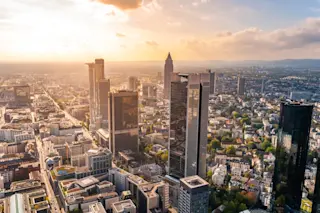The researchers studied how much fuel could be generated by installing a proposed new type of air conditioner at a landmark office building in downtown Frankfurt, Germany. (Credit: Bildgigant/shutterstock) In the hot and sticky suffocation of summer, air conditioners are a breezy balm. And as climate change heats Earth, the need for them is only rising. Yet the cold air blowers consume a ton of energy. But now researchers say they have a solution for these energy hogs that actually helps the climate. In a new analysis, scientists argue for using air conditioning units to capture carbon dioxide straight from the atmosphere and transform it into fuel. The idea is that these renewable-energy powered devices would lower atmospheric CO2 and provide a scalable alternative to oil, natural gas and other fossil fuels.
The conversion tech would first take in CO2 and water from the air. Then, an electric current would ...














